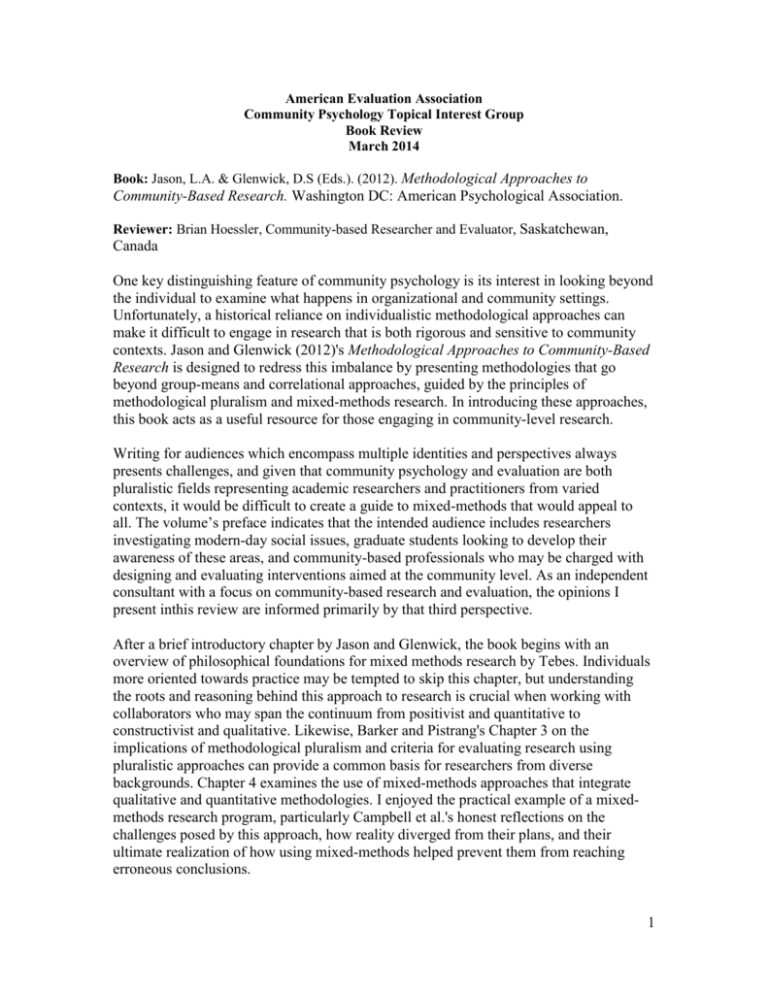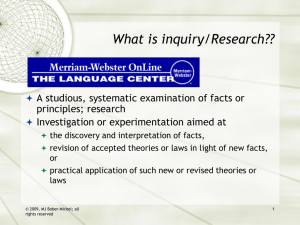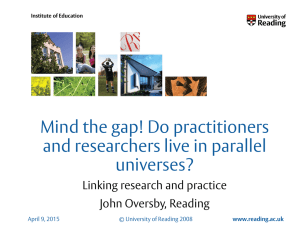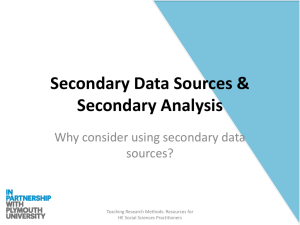American Evaluation Association Community Psychology Topical
advertisement

American Evaluation Association Community Psychology Topical Interest Group Book Review March 2014 Book: Jason, L.A. & Glenwick, D.S (Eds.). (2012). Methodological Approaches to Community-Based Research. Washington DC: American Psychological Association. Reviewer: Brian Hoessler, Community-based Researcher and Evaluator, Saskatchewan, Canada One key distinguishing feature of community psychology is its interest in looking beyond the individual to examine what happens in organizational and community settings. Unfortunately, a historical reliance on individualistic methodological approaches can make it difficult to engage in research that is both rigorous and sensitive to community contexts. Jason and Glenwick (2012)'s Methodological Approaches to Community-Based Research is designed to redress this imbalance by presenting methodologies that go beyond group-means and correlational approaches, guided by the principles of methodological pluralism and mixed-methods research. In introducing these approaches, this book acts as a useful resource for those engaging in community-level research. Writing for audiences which encompass multiple identities and perspectives always presents challenges, and given that community psychology and evaluation are both pluralistic fields representing academic researchers and practitioners from varied contexts, it would be difficult to create a guide to mixed-methods that would appeal to all. The volume’s preface indicates that the intended audience includes researchers investigating modern-day social issues, graduate students looking to develop their awareness of these areas, and community-based professionals who may be charged with designing and evaluating interventions aimed at the community level. As an independent consultant with a focus on community-based research and evaluation, the opinions I present inthis review are informed primarily by that third perspective. After a brief introductory chapter by Jason and Glenwick, the book begins with an overview of philosophical foundations for mixed methods research by Tebes. Individuals more oriented towards practice may be tempted to skip this chapter, but understanding the roots and reasoning behind this approach to research is crucial when working with collaborators who may span the continuum from positivist and quantitative to constructivist and qualitative. Likewise, Barker and Pistrang's Chapter 3 on the implications of methodological pluralism and criteria for evaluating research using pluralistic approaches can provide a common basis for researchers from diverse backgrounds. Chapter 4 examines the use of mixed-methods approaches that integrate qualitative and quantitative methodologies. I enjoyed the practical example of a mixedmethods research program, particularly Campbell et al.'s honest reflections on the challenges posed by this approach, how reality diverged from their plans, and their ultimate realization of how using mixed-methods helped prevent them from reaching erroneous conclusions. 1 The remaining chapters in the book focus on specific methods, each with a brief introduction to the approach and an example of its use: I found that this division of theory and methodology generally provided a useful introduction without delving too deeply into the details. Most of these chapters included supplemental information through the book's companion website,such as data sets for practice: unfortunately, the utility of this data is decreased for practitioners who may lack access to programs such as SPSS and SAS. Chapters 5 through 7 examine alternate methods of grouping data. Dymnicki and Henry's chapter on cluster analysis and Bogat et al.'s introduction to the person-oriented approach provide a good overview of these methodologies and their benefits compared to aggregate methods such as ANOVAs and correlational analysis. The brief introduction to the person-oriented approach particularly piqued my interest.Unfortunately, the chapter's focus on statistical methodology made it difficult to understand the general approach and its potential applicability. As presented, these two approaches appear to be so specialized that they cannot be used easily outside of an academic or institutional research context. Durlak and Pachan’sintroduction in Chapter 7 to meta-analysis includes a useful example that demonstrates this method's growing utilizationin the evaluation sphere. The authors' focus on the steps and features associated with a quality meta-analysis ensures that this chapter is equally useful for community practitioners who are more likely to be consumers of this research approach rather than producers. Chapters 8 and 9 focus on methodologies involving change over time. As demonstrated in Hoeppner and Proeschold-Bell's chapter on time-series analysis, these approaches can be particularly useful in evaluation contexts to investigate causality, especially in community settings where the use of randomized control trials may be infeasible or inappropriate. Formative and developmental evaluations can benefit from using survival analysis, as described in Connell’s contribution, to identify predictive factors for program completion or post-intervention relapse: I would have preferred a real-world example over a hypothetical case to further emphasize the potential utility of this approach. The final four chapters’focus on methods for analyzing contextual factorswould likely be themost interesting to community practitioners; however, the details can make these methods challenging to implement. Multi-level modeling, covered by Todd, Allen, and Javdani in Chapter 10, is useful for analyzing nested data whereevaluations encompass both individual- and community-level information.The complexity involved in such analyses,however,puts this beyond the use of most community practitioners. Jason, Porter, and Rademaker introduce the epidemiological approach in Chapter 11, connecting a long-standing public health method to our field. The section ends with chapters on Geographic Information Systems by Morton et al. and economic cost analyses by Lo Sasso and Jason. These methods are increasingly important for community research and evaluation, so I was thankful to see their inclusion in this volume. If asked whether this book would be useful for a community practitioner who identifies with community psychology and evaluation, my answer would likely be, "it depends". The diversity of community contexts and partners encourages a broader awareness and 2 appreciation of the expanse of methodologies and approaches if for no other reason than to avoid a completely blank-faced expression when a potential client, research colleague, or community partner inquiries about your familiarity with Method “X”. In addition, the inclusion of research examples in most chapters can help practitioners understand the potential applications of these methods, thus expanding our evaluation "toolkits" as we encounter novel situations in our work. Notwithstanding the stated audience of both researchers and community professionals, the focus and tone of the book feels more strongly weighted towards academia. This approach can be advantageous in several situations.For example, I look forward toutilizing this book as a reference when working with academic partners in communityuniversity research partnerships. However, many of the presented examples and methods fall outside the realm of practitioners who are working independently or in small organizations.More practical examples of economic cost analysis, time-series analysis, or even the person-oriented approach using more readily availableanalysis tools would greatly add to the book’s context and speak to a broader audience of evaluators. To be fair, methods such as meta-analyses or multi-level modeling are often beyond the means of an independent practitioner, but some approaches could be adapted for use on a smaller scale. Overall, Jason and Glenwick’s volume is a usefulresource for academic researchers and community practitioners, especially those working with university partners. 3







